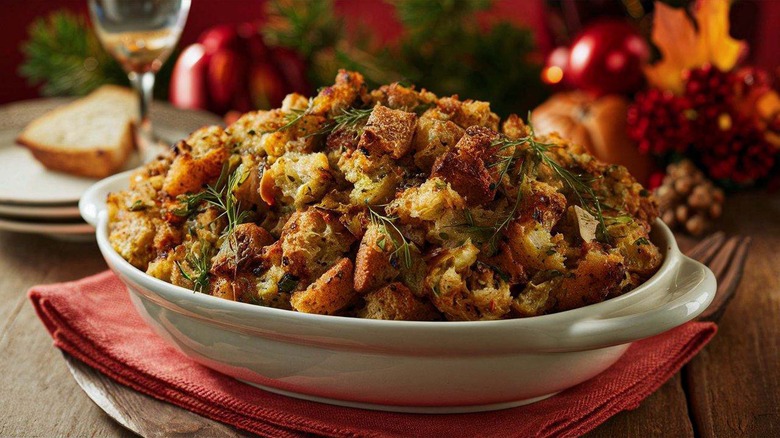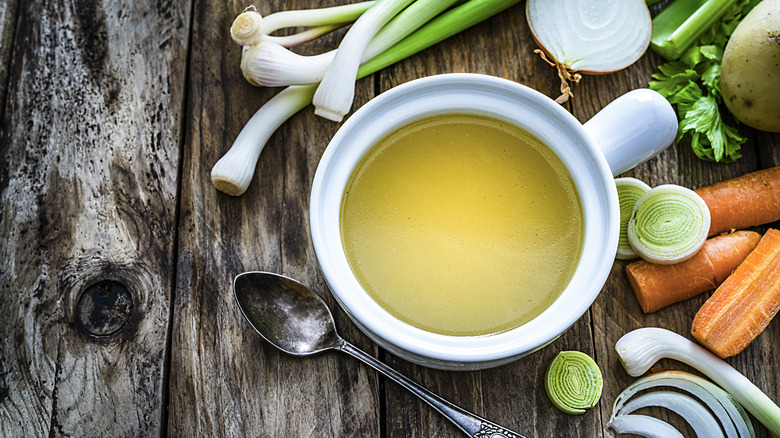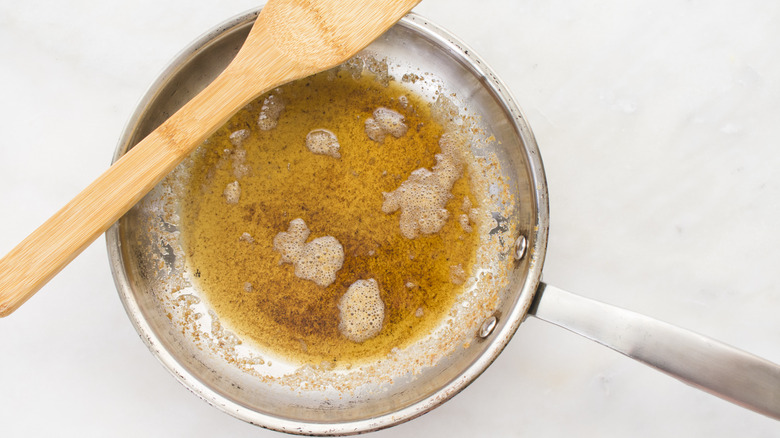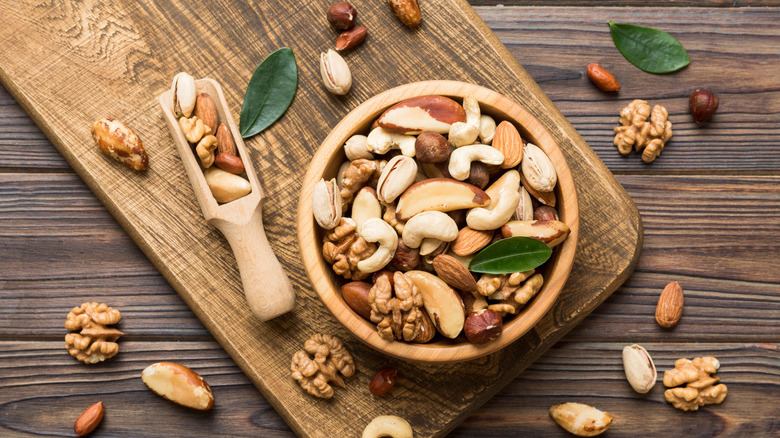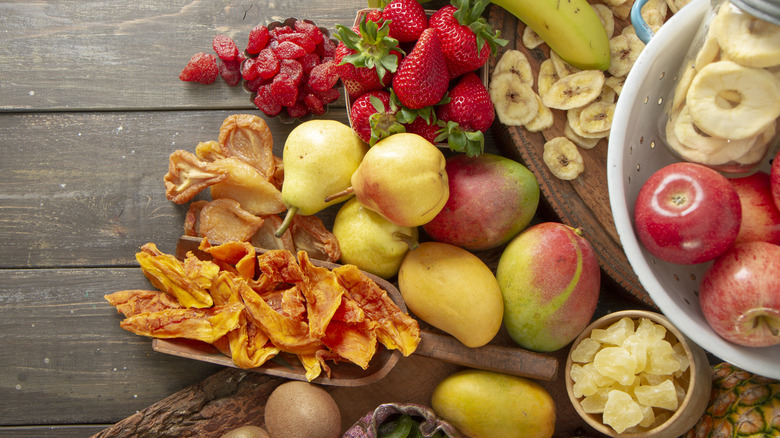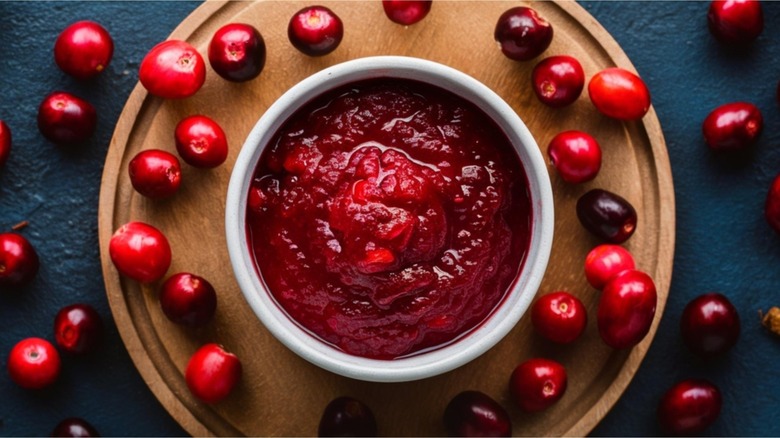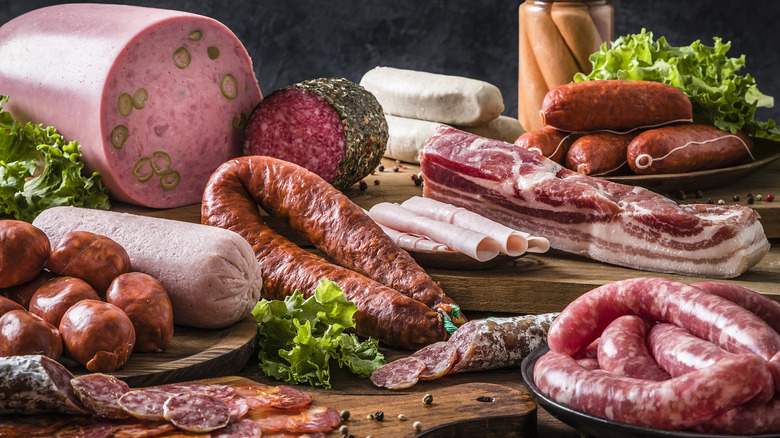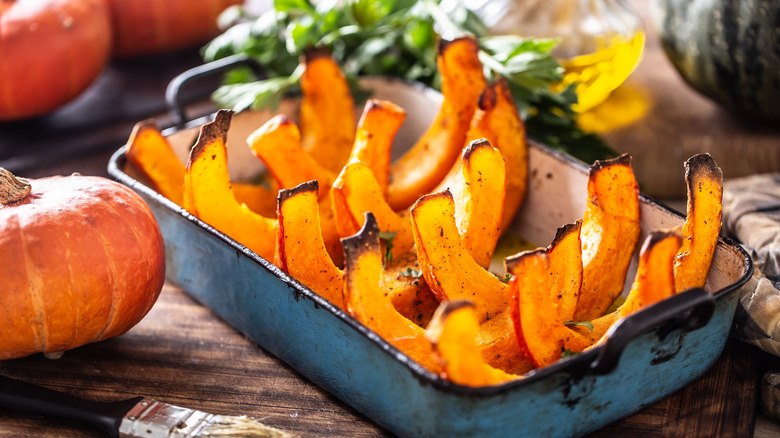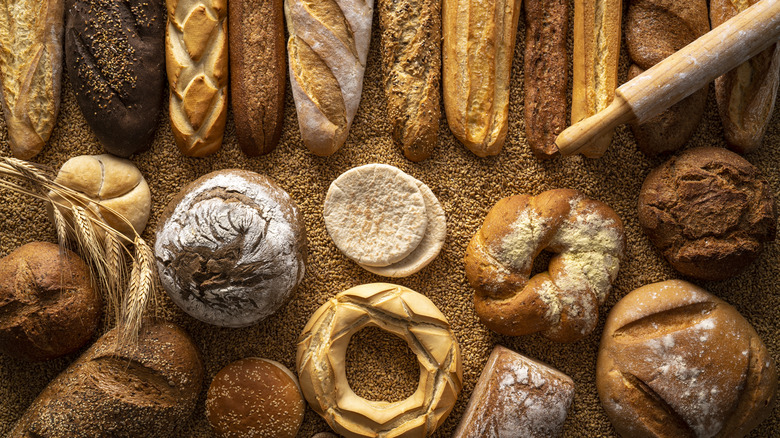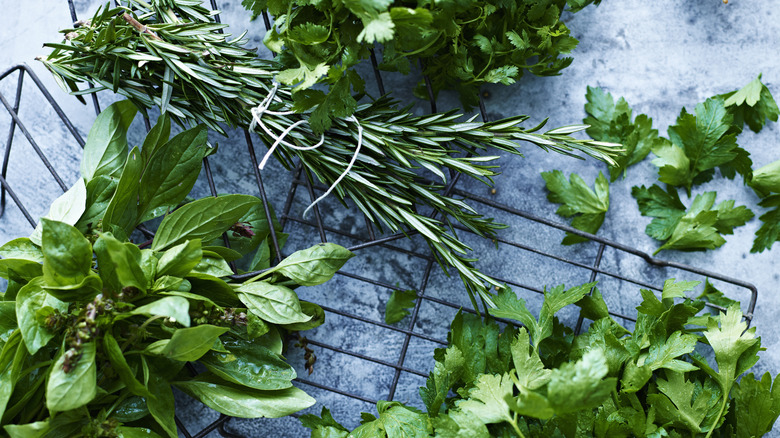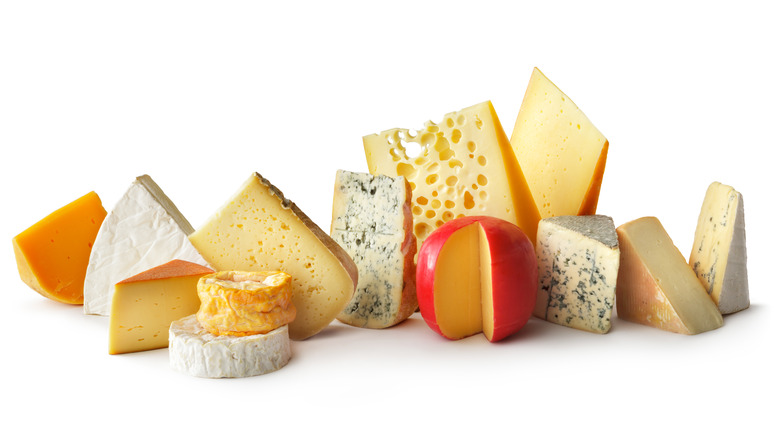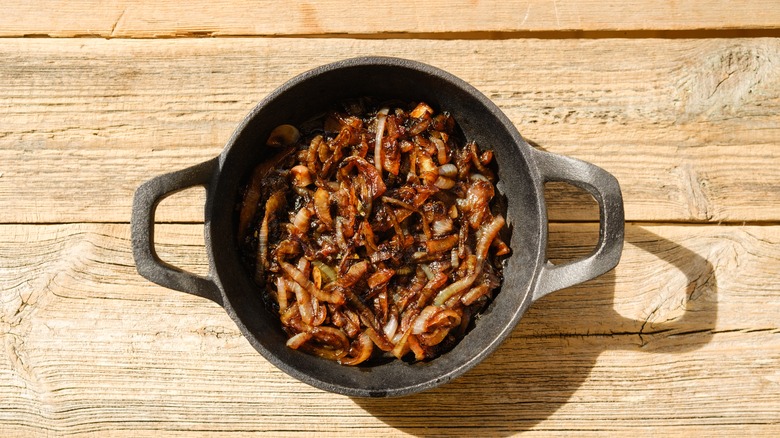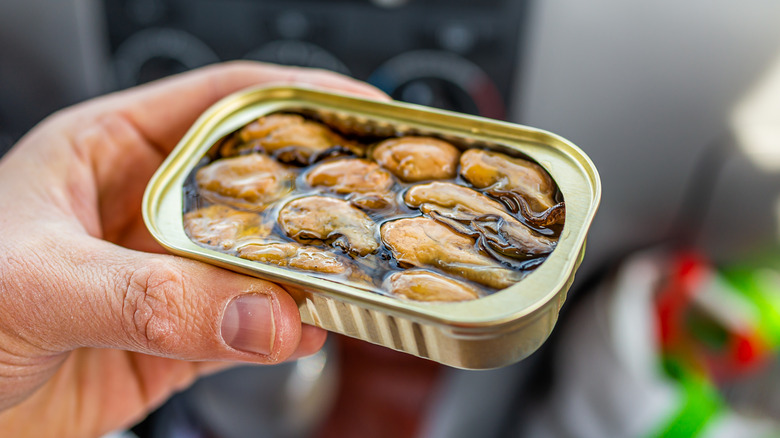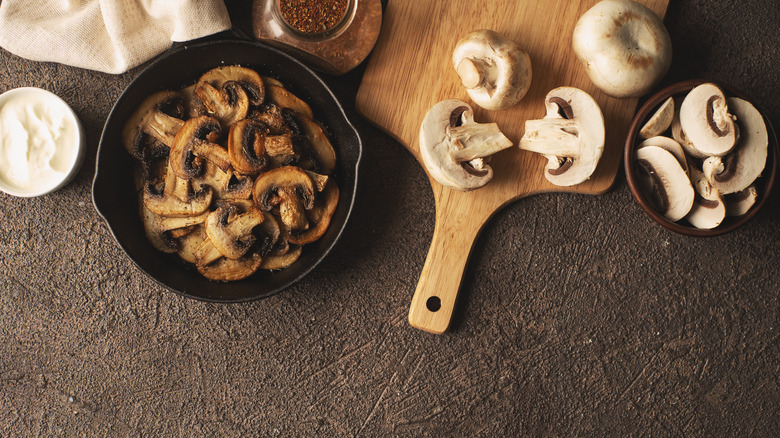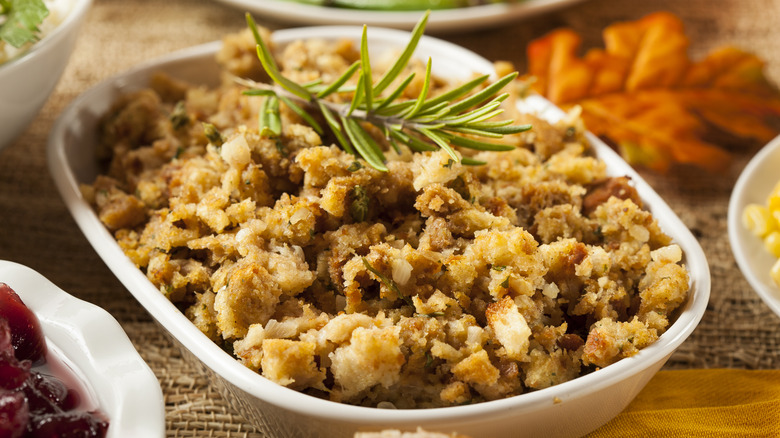14 Ways To Take Boxed Stuffing To The Next Level
We may receive a commission on purchases made from links.
Whether you call it dressing or stuffing, few dishes scream the holidays like this one. In fact, stuffing frequently tops the list of favorite foods when it comes to Thanksgiving side dishes. Though endless homemade recipes for this holiday classic exist, by the time the turkey is roasted, the pies are baked, and the potatoes are mashed, some of us opt to supplement our festive meal with a store-bought version of this dish.
While there is nothing wrong with using a store-bought stuffing brand — and many, like the well-known Stove Top, are beloved for their consistent quality, fluffy texture, and flavor — even the best boxed stuffing can leave a lot to be desired when compared with something made from scratch. That said, if you do opt to use boxed stuffing this holiday season, there are ways to transform it from average to awesome.
That's where I come in. As a professional chef, I am no stranger to transforming the ordinary to the extraordinary. I love the challenge of elevating something, like boxed stuffing, into a gourmet dish, using just a few unique ingredients or culinary techniques, and I am prepared to share these with you. Read on for the many ways you can take boxed stuffing to the next level this holiday season.
1. Use a different kind of liquid
Most store-brand stuffing mixes require the contents to be rehydrated using water. Though the recipe is formulated using water, the end result is often somewhat bland. A great way of infusing flavor into boxed stuffing is to swap the water with another liquid.
The options for this are virtually endless, though it is always a good idea to consider the amount of sodium you may be adding, particularly if you are using stock or broth. Opt for low-sodium varieties where possible. If you are seeking something with a zing, consider using apple cider vinegar or pickle juice. For something with a tropical vibe, coconut water or milk can be a great option. And, beer or wine can provide complexity, but may not be suitable for all your guests.
Perhaps my favorite liquid to use for stuffing is dashi. This stock commonly found in Japanese cooking is made from dried kelp and dehydrated, fermented, smoked bonito or skipjack tuna flakes, creating an umami-rich, complex flavor that will instantly transform stuffing into something sophisticated.
2. Incorporate brown butter
Another key ingredient used to add flavor and fat to boxed stuffing is butter. Though plain butter is good, there is something even better — brown butter. Brown butter, or beurre noisette, is a fancy French culinary technique. It involves heating butter until the water evaporates, leaving behind the nutty, caramelized milk solids. While the key to executing this sauce to perfection begins with a high-quality, high-fat butter, there are ways of elevating brown butter that can make it even more flavorful.
For a boost of acidity, a dash of lemon or orange juice can brighten up brown butter, while vanilla extract can help to accentuate its inherent nuttiness. And, finely chopped herbs, like sage, thyme, or rosemary, can help to infuse some freshness and verdant color into the mix.
Another fancy chef hack is to whisk in some powdered milk into the butter as it slowly heats through. The addition of more milk solids will increase its savory flavor, while giving it some body. If you don't want any residual clumps of powdered milk in your stuffing, you can strain the brown butter before adding it to your recipe.
3. Add crunch with nuts
When a chef thinks about taking a dish to the next level, one of the first things we consider is incorporating different textures. Stuffing tends to be fluffy and can get quite soggy as it sits for a while. To combat this, a layer of crunch is needed, and one of the best ingredients for this is nuts.
Though you can use any kind of nut you enjoy, there are some key factors to consider. Every type of nut has a distinct flavor and texture. Some may have a bitter undertone, while others may be more creamy than crunchy. For the sake of interest and complexity, I recommend using two or three different, yet complementary, types of unsalted nuts for this purpose. Personal favorites include almonds, cashews, and hazelnuts.
Among the biggest mistakes you can make when cooking with nuts is failing to toast them before adding them to your stuffing. Each nut should be toasted individually until just golden brown and aromatic. Once toasted, chop the nuts while warm before adding them to your recipe. And, it goes without saying, but you should always check to make sure your nuts are fresh.
4. Toss in fresh or dried fruit
Another great hack when trying to add nuance to a dish is to build different layers of flavors. When working with a savory recipe, like stuffing, you want to incorporate sweet elements that can amplify salty, bitter, and sour ones. Fresh or dried fruit can both work beautifully in this capacity, though dried fruit has the added bonus of imparting a chewy texture, which can enhance complexity even further.
It is important to keep in mind that fresh fruit will leach liquid as it heats up, which can make your stuffing soggier. That doesn't mean you can't use it, but you may want to opt for firmer-fleshed fruits, like apples or pears, and add them at the end of the cooking process so they retain their texture. You can also use canned fruit, which is already partially cooked, making it less likely to water down your stuffing.
When it comes to dried fruit, though you can add it as-is, rehydrating it before putting it in the stuffing can make it slightly less toothsome. Try using different liquids, like coconut water, tea, juice, brandy, or fortified wine, to resuscitate particularly dense dried fruit and infuse it with extra flavor.
5. Marry it with cranberry sauce
Cranberry sauce is a staple of the Thanksgiving meal, whether you make your own or rely on a classic canned standby, like Ocean Spray Jellied Cranberry Sauce. Though the sauce can be served as-is, as one of the many side dishes available to accompany the turkey, it can make a great addition to store-bought stuffing mix.
In fact, you may be doing both store-bought stuffing and store-bought cranberry sauce a favor by combining them. Heating canned cranberry sauce is one way to enhance its flavor. Not only does the heat transform its texture from gelatinous to syrupy, it amplifies the tart aroma and flavor of the cranberries. Just be careful not to add too much liquid to the stuffing mix if you plan to use canned cranberry, otherwise it can get too gloopy.
To really transform your tangy cranberry-infused stuffing, toss in some orange zest, dried cranberries, and chopped pecans, for added flavor and texture. This mash-up is sure to become a new family favorite, and it makes for a dynamite casserole when combined with leftover turkey and creamed corn.
6. Make it meaty
Many of the best homemade stuffing recipes include a meaty component to jazz things up. Whether it is sausage, bacon, or pancetta, a meaty element can help to amplify the savoriness of a store-bought stuffing mix, while providing a more robust texture. The key is to select your protein of choice carefully.
While it may be tempting to use chicken or turkey sausage or bacon, I recommend against it, as you don't want to compete with the star of the holiday table, namely the turkey. Though my favorite meaty components are porcine in origin, there are other options, including beef or even lamb sausages, like a spicy Moroccan merguez.
Whichever protein you select, you will want to cook it thoroughly before adding it to your store-bought stuffing. Doing so will help to ensure it is safe to consume and its natural flavor is enhanced, which is amplified as the meat browns and is transformed by the Maillard reaction. Lastly, make sure to cut the meat into smaller pieces that can be evenly distributed throughout the stuffing, so you get a savory morsel in every bite.
7. Pop in some winter squash
Though you can use myriad vegetables to supplement boxed stuffing and give it extra flavor, color, and a healthy dose of nutrients, few are as well-suited to this job as the family of winter squashes. Whether you are using butternut, acorn, spaghetti, or kabocha squash, these hearty, firm-fleshed specimens have an inherent sweetness and nuttiness that can completely transform stuffing.
Regardless of which winter squash you decide to add to store-bought stuffing, it will need to be cooked before it can be used. There are a number of ways to prepare winter squash, including microwaving, boiling, and baking it. That said, my favorite method of cooking it is to roast it. Doing so encourages the natural sugars in the squash to caramelize, giving it a distinctive toasty flavor and a firm, yet supple, texture that is far more complex.
To really amplify the flavor of the squash, drizzle it with olive oil and season it liberally with your favorite seasonings. I often choose herbes de Provence, a dash of smoked paprika for heat, and a pinch of freshly grated nutmeg for sweetness.
8. Boost it with different types of bread
One of the primary components of any stuffing recipe is the bread. Though most boxed stuffing mixes use a relatively basic white bread, there is no reason why you couldn't augment this with a variety of other breads to help improve the texture and flavor of the final product.
There are a number of great contenders for this, ranging from cornbread and challah to brioche and sourdough. Some even swear by the distinct flavor and starchiness of potato bread to produce a complex stuffing. While any of these will work, there is one key to adding bread to stuffing — it must be dry, not stale.
If you are wondering what the difference is between the two, stale bread can still retain pockets of moisture that will prevent it from taking on any liquid added to the recipe, thereby producing soupy stuffing. Bread that has been dried, lacks these pockets, allowing for all that buttery and brothy goodness to be soaked up.
The best way to dry bread for stuffing is to do so in the oven. Set it on a low temperature and allow the cubes of bread to remain there until they become crunchy and totally dehydrated. You may need to toss the cubes occasionally to promote even drying.
9. Freshen it up with herbs
One way to finish off any dish is to add some fresh herbs before plating it up. Fresh herbs not only add a verdant color to the recipe, they impart a bright, grassy flavor that can enhance savory elements and offset fatty ones. When it comes to boxed stuffing, while there may be some dried herbs already in the mix, these are few and far between. Augmenting these with similar fresh herbs can help to bring out this flavor and give it that "homemade" feel.
Among the common mistakes made when cooking with herbs is getting overly complicated with them. I like to use two to three herbs max that are complementary, like rosemary, sage, tarragon, or thyme. But, don't be afraid to think outside the box. Fresh basil or mint can be a bright change of pace that is less woodsy and can provide a little international flair.
Also, you do not want to chop and add the herbs too soon. They should be processed and thrown in right before the stuffing is served so that they do not get bruised or wilted, which can impact their freshness, vibrancy, and texture.
10. Say cheese
If you are looking for a way to incorporate creaminess, add savoriness, and infuse pungent flavor to boxed stuffing, just say "cheese." Few ingredients can transform virtually anything from mediocre to marvelous like some cheese. A good way to look at adding cheese into stuffing is to treat it the way you would macaroni and cheese. You will want to use high-quality melting cheeses that are crumbled or shredded finely enough to dissolve into the stuffing completely.
While one strong cheese, like a sharp cheddar or a spicy pepper jack, would be good, a combination of two or three different, yet complementary, ones would be better. And, don't be afraid to go bold with taste. This is a great place to use intensely-flavored cheeses, like roquefort, gorgonzola, or a smoked gouda. The distinct taste of these cheeses can balance out sweeter elements on the holiday table, from a classic sweet potato casserole with marshmallows to a luxurious pumpkin or pecan pie.
11. Sophisticate it with caramelized onions
Anyone who has enjoyed a piping hot bowl of French onion soup understands that caramelized onions will certainly enhance the flavor and sophistication of store-bought stuffing. The process of slowly caramelizing onions allows for the sugars in them to break down and develop that rich, deep, brown color that is loaded with sweet, savory, and smoky elements that are sure to titillate your taste buds.
The operative word here is "slow." You cannot rush the caramelization process, otherwise you will end up with burnt onions, which means you need to cook them over a low heat, while stirring occasionally. Though you can caramelize any kind of onion, those with a naturally higher sugar content, like Vidalias, tend to develop an especially concentrated, sweet flavor. For complexity, however, you might consider combining different types of onions for the most robust taste.
Other ways to kick your caramelized onion game up a notch include adding both salt and sugar and tossing in a bit of baking powder. This magical trio will help speed up the process of caramelizing onions by softening them quicker, and will enhance their sweetness. Additionally, don't forget to season your onions. A dash of cayenne, freshly grated nutmeg, or black pepper can counteract the sweetness with a hint of spice and add a layer of nuance that will make your stuffing pop.
12. Included some smoked oysters
A classic oyster stuffing is not a novelty. This recipe has been a staple among New Englanders since the 18th century, when oysters were not only more cost-effective sources of protein, but more readily available than other types of meat or seafood. Though fresh oysters would have been used in the historical version of this recipe, there is no reason to bust out your quality shucking knife to replicate this dish using store-bought stuffing. Simply purchase a high-quality can of smoked oysters to save time and your digits.
Before using canned oysters, you will want to drain and rinse them to eliminate the brine and any excess salinity. This brine can be reserved for use in seafood chowders, but adding it to boxed stuffing may make the dish too salty. Though you can add the oysters in whole, you may prefer to chop them into smaller pieces so that they are more evenly distributed throughout your stuffing and you get smaller bites, which will help offset their slightly toothsome texture.
13. Up the ante with umami-rich elements
Chefs all know that the key to developing complex flavor in any dish is to incorporate elements that can satiate every one of the five basic components of taste: sweet, salty, sour, bitter, and umami. While we have already discussed a few ingredients that fit under the umbrella of umami-rich notes, such as oysters, cheese, and nuts, there are many other ways of adding this flavor into your store-bought stuffing mix.
Before we identify some of these, it is helpful to note that something that is salty isn't necessarily also umami-filled. In fact, the term "umami" roughly translates to "pleasant savory taste" in Japanese, reflecting the fact that the key amino acid responsible for this flavor is glutamate, which is often characterized as having a meaty pungency.
Examples of ingredients that are overflowing with umami flavor include Worcestershire sauce, soy sauce, gochujang, miso, mushrooms, and tomatoes. Any of these can easily be added to boxed stuffing mix to transform its flavor, but be mindful of the salinity, particularly in the condiments. A little goes a long way when it comes to these. To add umami without salinity, it may be better to opt for sautéed or roasted mushrooms or sun-dried tomatoes, which are naturally rich in glutamate.
14. Bake your stuffing in the oven
What's better than a bowl of macaroni and cheese? A bowl of baked macaroni and cheese. This logic can also be applied to stuffing. While cooking boxed stuffing on the stove top is certainly convenient, the texture often leaves a lot to be desired. For this reason, transferring it to a baking dish and popping it into the oven can help firm up the texture, eliminating excess moisture, and giving the top a pleasant crunch.
For best results, opt for a shallow baking dish. Doing so increases the surface area exposed to the heat, thereby allowing for a crisper texture overall. Just be cautious not to over bake the stuffing. A shallow baking dish will require less time in the oven and can easily burn if allowed to bake for too long.
Lastly, before baking off your stuffing, try dusting it with a topping to help create a satisfying crust. Cheese, bread crumbs, and nuts are always a good idea, but thinking outside the box (or perhaps inside the cereal box) might be a game changer. Leftover cereal can make a great topping for store-bought stuffing. Depending on your tastes, you can go one of two ways. You can use a sweet cereal, like Cinnamon Toast Crunch, to create a contrast between sweet and savory, or you can stick with unsweetened options, like Kellogg's Corn Flakes, if you prefer to keep things on the savory side.
